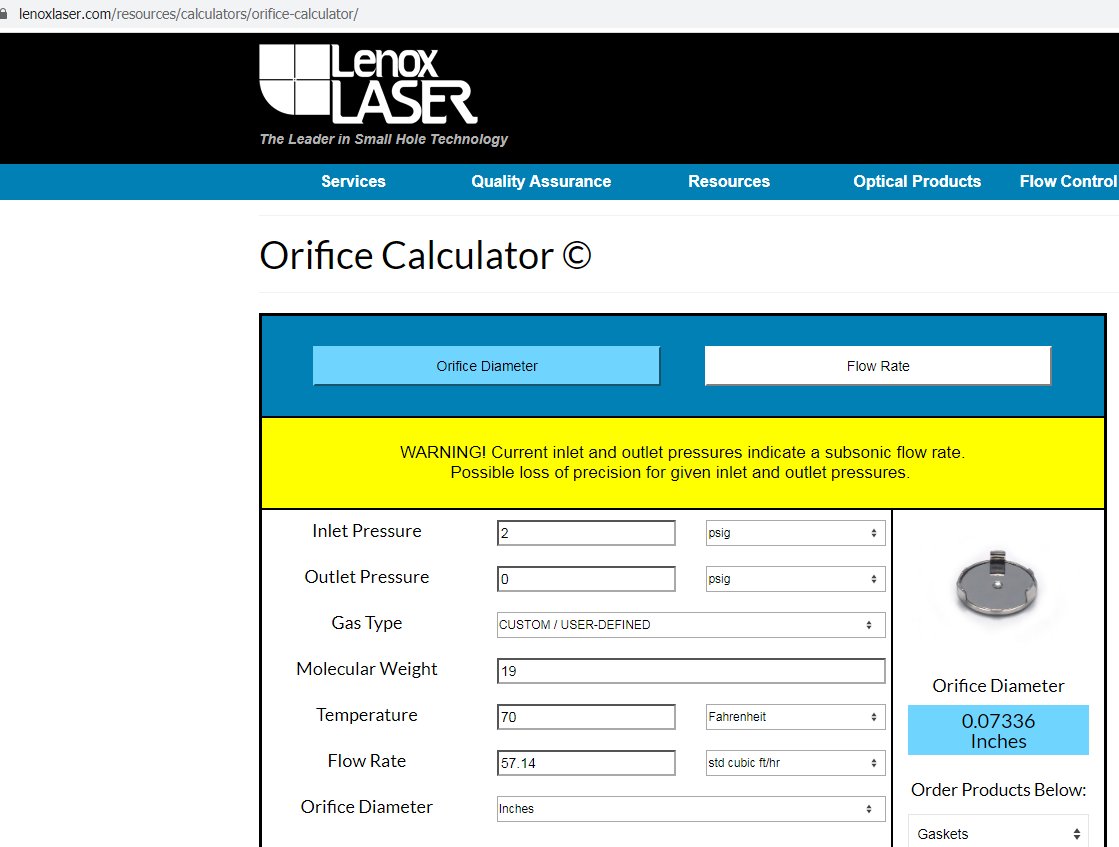Mr Heater Torpedo Heater - Propane to Natural Gas Conversion
Mr Heater Forced Air Propane Construction Heater Model MH60QFAV, 30-60K Btu heater.
The newer Mr Heater torpedo heaters are very quiet compared to models from a few years ago.
I have 2 psi, medium pressure Natural Gas that I ran into my shop. Normally a regulator is used to lower the pressure to about 7 inches of water for most natural gas heaters. However this propane powered heater is normally supplied with propane at 20psi with the included regulator.
I took the heater apart and found that the original orifice is 0.9 mm or 0.035 inches in diameter. Quite small. Since I wanted to run it off 2 psi Natural gas the orifice would need to be bigger, but how much?
I found this website:
Lenox Laser Orifice CalculatorI entered the numbers as shown. Natural gas has about 1050 btu per cu ft. So 60,000 btu/hr divided by 1050 came to about 57 cu ft per hour. The exit pressure is basically zero since the orifice ejects the gas into a bigger pipe in the burner assembly and blows the mixed fuel and air to the burner.

The results say that the orifice has to be about 0.073 inches in diameter. I have a set of wire gauge drills (number drills) and the closest is a #49 drill. I have a high speed drill press and I drilled out the orifice (after removing it).
To get the orifice out:
1. Remove the bottom cover ( 4 screws)
2. Cut the tie wrap holding the wires together.
3. Remove the U gas tube from the burner pipe.
4. Remove the screw at the base of the burner tube as it goes into the "torpedo"
5. Remove the fan wiring connectors from the board (2 black wires)
6. Remove the fan (4 screws) and set it aside.
7. Remove the screw holding the burner tube to the burner plate
8. Tip the burner tube and remove two screws holding the 90 degreecast fitting at the bottom of the burner tube.
9. Remove the casting
10. Unscrew the orifice jet.
11. Drill the orifice and reassemble
The gas regulator for propane is not required.
To remove the regulator from the hose fitting you need to heat the regulator casting with a hot hair dryer or hot air gun.
The fitting is screwed into the regulator with some hardening "glue" which locks it in place.
Heating the casting and fitting slightly will break the bond.
I screwed the hose into a tap off my gas line and I included a ball valve so I can remove the hose or turn off the gas when not needed.
Note that if you don't have 2psi gas available, you will need a larger hole in your jet. If you enter 1/4 psi in the gas calculator you will probably get a drill size which is close. Normal natural gas pressure is 5-7 inches of water. 0.7 inches of water is about .25 PSI. With 1/4 psi I get a required jet of 0.14 inches.
If you look at the hose fittings that come with the heater you will see that the hose fitting has holes in them not much bigger than 0.14 inches.
Two things you can do.... remove the jet entirely and see how the heater works. If it doesn't burn properly and doesn't work well, try drilling the existing jet out to 0.14. You may need to get a bigger hose. The fitting on the back of the heater is a 3/8" flare fitting. It should not be hard to buy a 3/8" hose to get this to work on normal low pressure gas.
As you'd expect, this is all experimental. If you burn down your house/garage, etc its because you weren't qualified to do this. However this works for me.
The safety features on the heater and the turn down knob on the side of the heater work fine with my 2psi gas conversion. A flame out, shuts off the gas. The high temp limit should work as before. A loss of gas pressure also safely shuts down the gas flow. With the heat control knob, Its really nice to be able to throttle the heater down if desired.
I paid $139 with tax for this heater. Natural gas torpedo heaters of this size are not available. I have no idea why. Natural gas is safer than propane and it doesn't require tanks. If I was to run this heater off of propane, I would need several 100 lb propane tanks and I would be tempted to keep them in the shop (not a great idea) to minimize hose runs. Then I would need to drag them to a refill facility frequently if I was running the heater frequently. Natural gas is about 1/4 the price of propane around here. Maybe less. Running the heater for an hour at full output costs about 50 cents.